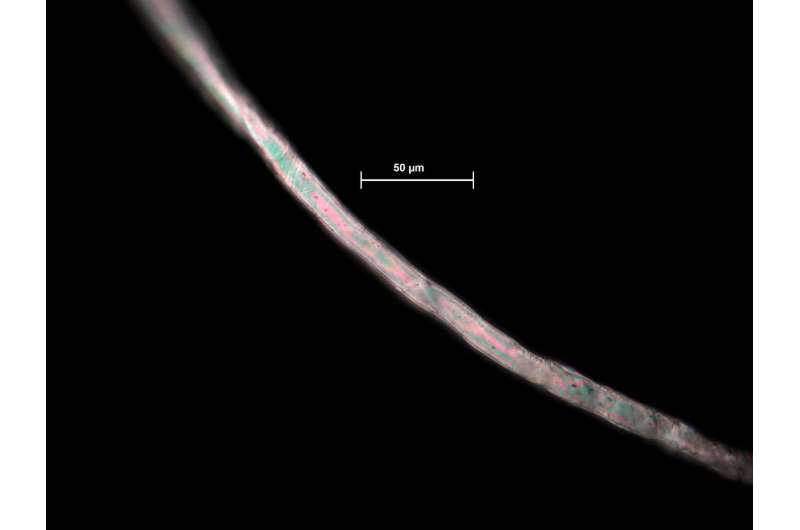Polyester microfiber obtained in the Atlantic Ocean marine floors in a similar study. Credit: Lucy Woodall/London Natural History Museum
A study led by researchers of the University of Barcelona quantifies the presence of textile microfibers in south European marine floors from the Cantabrian Sea to the Black Sea. The study has analysed the amount of these colored fibers, which vary between three to eight millimeters but are extremely fine, less than a 0.1 mm diameter, and which come mainly from home and industrial washing machines. The results show the dominance of cellulosic fibers over synthetic polymers, and highlight that several oceanographic processes pile and transport microfibers to marine hollows.
These are some of the main conclusions of the article published in the scientific journal PLOS ONE by researchers Anna Sánchez Vidal, William P. de Haan and Miquel canals, in collaboration with Richard C. Thompson from the University of Plymouth (United Kingdom). According to the researchers, the study reports the presence of this residue in marine floors and could help designing effective management strategies to reduce the emission of microfibers with a potential negative effect on the marine ecosystems.
Residue at 2,000 meters depth
Microfibers are among the most common microplastics in the marine environment, but such a deep study had not been carried out so far in a large area. Researchers analysed soil samples from 42 and 3,500 meters deep in 29 stations in southern European seas. The results show that higher densities of fiber are found in the Cantabrian Sea, followed by the Catalan seas and the Alboran Sea, respectively, while lower densities are in the western Mediterranean and the Black Sea.
The study also shows distance in deep seas is not a barrier to the accumulation of microfibers, since about 20 percent of these particles are accumulated in the open sea beyond 2,000 meters deep. "Textile microfibers seem to concentrate at the bottom of submarine canyons, while the quantity in the slope is significantly lower. This suggests microfibers, probably coming from the ground (a washing machine can release up to 700,000 microfibers to waste waters in one use), are accumulated in the continental platform, from where they are swept and taken by several oceanographic processes to marine hollows through the natural conducts -marine canyons," says Anna Sánchez Vidal, from the Department of Earth and Ocean Dynamics.
Microfibers in deep water organisms
These findings also confirm previous studies that detected microfibers that were ingested by deep water organisms in a natural environment. "Recent results show ingesting of microplastics by different organisms and in different ecosystems, but the specific impact on the organisms is unknown," says Anna Sánchez Vidal. "It can depend on a wide range of factors, such as features of the microfibers (size, abundance), or chemical substances these absorbed as well as the physiology and ecology (size, feeding, whether they excrete or accumulate, etc.) of marine organisms."
The researchers mainly found natural cellulose (cotton, linen) fibers and regenerated cellulose (rayon of viscose) from clothes and industrial textiles. Polyester is the most common synthetic microfiber, followed by acrylic, polyamide, polythene and polypropylene. "Some of these synthetic microfibers are made of plastic, which does not degrade quickly, and it can contain chemical additives that can be easily incorporated to the trophic network," highlights the researcher.
Measures to reduce emissions
For the researchers, the presence and persistence of microfibers in marine soils and the negative impact they have on marine organisms in the long run makes it clear there is a need to design effective management strategies to reduce the emission. "We need to advance in research and innovation in the textile industry, in the design of effective filters for washing machines, in the treatment of waste waters, and the promotion of sustainable clothing," concludes Sánchez Vidal.
More information: Anna Sanchez-Vidal et al, The imprint of microfibres in southern European deep seas, PLOS ONE (2018). DOI: 10.1371/journal.pone.0207033
Journal information: PLoS ONE
Provided by University of Barcelona























